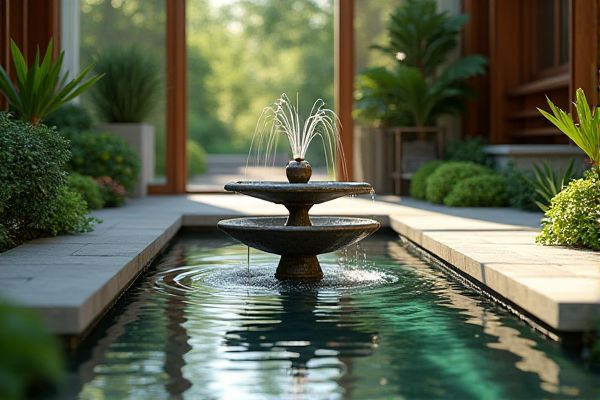
A water fountain offers a controlled, decorative water feature that can enhance Your garden's aesthetics with soothing sounds and low maintenance, while a pond provides a natural habitat supporting diverse aquatic life but requires more upkeep and space. Explore the rest of the article to discover which option best suits Your outdoor space and lifestyle.
Table of Comparison
| Feature | Water Fountain | Pond |
|---|---|---|
| Water Source | Recirculated water via pump | Natural or artificial water body |
| Size | Small to medium, space-friendly | Medium to large, requires more space |
| Maintenance | Moderate; requires pump cleaning, water treatment | High; algae control, wildlife management, cleaning |
| Wildlife Attraction | Limited; mostly birds | High; supports fish, amphibians, insects, birds |
| Installation Cost | Low to moderate | Moderate to high |
| Aesthetic Appeal | Modern, architectural | Natural, scenic |
| Water Movement | Continuous, aerates water | Usually stagnant or slow-moving |
| Environmental Impact | Minimal, controlled ecosystem | Supports biodiversity, greater environmental role |
Overview of Water Fountains and Ponds
Water fountains create dynamic visual appeal and soothing soundscapes through circulating water jets, making them ideal for decorative and therapeutic purposes in urban and garden settings. Ponds serve as natural or artificial bodies of still water that support aquatic ecosystems and provide habitats for wildlife, offering ecological balance and aesthetic tranquility in landscape design. Both features enhance outdoor spaces but differ in maintenance, biodiversity impact, and functional roles.
Key Differences Between Water Fountains and Ponds
Water fountains typically feature continuous flowing water, creating soothing sound and visual movement, while ponds comprise a still body of water often supporting aquatic life and plants. Ponds require more maintenance to manage algae, water quality, and ecosystem balance, whereas water fountains demand regular upkeep of pumps and filters for optimal performance. Your choice depends on whether you prefer the dynamic aesthetic and sound of a fountain or the natural habitat and tranquil stillness of a pond.
Aesthetic Appeal: Fountains vs Ponds
Water fountains create a dynamic aesthetic appeal through flowing water and visual movement, often serving as striking focal points in gardens or courtyards. Ponds offer a serene, naturalistic beauty with reflective surfaces and aquatic life that enhance tranquility and biodiversity in your outdoor space. Your choice depends on whether you prefer the energetic charm of a fountain or the peaceful allure of a pond.
Space and Installation Requirements
Water fountains generally require less space and simpler installation compared to ponds, making them suitable for smaller gardens or patios. Ponds demand a larger area and more complex setup, including excavation, waterproof liners, and filtration systems. Your choice depends on available space and how much effort you're willing to invest in installation and upkeep.
Maintenance Needs for Fountains and Ponds
Water fountains require regular cleaning to prevent algae buildup and maintain pump functionality, typically needing weekly water changes and filter replacements. Ponds demand more extensive maintenance, including monitoring water quality, managing plant growth, and controlling fish health, often requiring monthly partial water changes and seasonal care. You can reduce upkeep effort for both by installing automated filtration systems and using beneficial bacteria treatments.
Cost Comparison: Initial and Long-term Expenses
Water fountains generally have lower initial costs compared to ponds, as they require less excavation and fewer materials. However, long-term expenses for fountains may include regular pump maintenance and electricity fees, while ponds often incur higher costs for water treatment, landscaping, and potential wildlife management. Your choice should consider these ongoing expenses to ensure a sustainable and cost-effective water feature.
Environmental Impact and Sustainability
Water fountains often consume more energy due to continuous pump operation, increasing your environmental footprint, while ponds rely on natural water cycles, promoting biodiversity and ecological balance. Ponds provide habitats for wildlife such as amphibians and aquatic plants, enhancing local ecosystems and encouraging sustainability. Choosing a pond reduces maintenance needs and chemical treatments typically required for fountains, supporting a more eco-friendly outdoor space.
Wildlife Attraction: Supporting Local Ecosystems
Water fountains create moving water that attracts birds and pollinators, enhancing your garden's biodiversity. Ponds offer a larger habitat with still water, supporting amphibians, fish, and aquatic plants vital for local ecosystems. Choosing between them depends on the level of wildlife support you want to encourage in your outdoor space.
Customization and Design Flexibility
Water fountains offer extensive customization and design flexibility, allowing you to select from various materials, shapes, and lighting options for a tailored aesthetic. Ponds provide natural, organic designs with opportunities to incorporate aquatic plants and wildlife, enhancing biodiversity and tranquility. Choosing between a fountain and a pond depends on your desired level of maintenance, space availability, and the ambiance you wish to create in your outdoor area.
Choosing the Best Option for Your Landscape
Water fountains offer a dynamic focal point with soothing sounds that enhance your outdoor space, while ponds provide a natural habitat supporting diverse aquatic life and creating a tranquil environment. When choosing the best option for your landscape, consider maintenance requirements, space availability, and aesthetic goals to match your lifestyle and preferences. Your decision should balance visual appeal and ecological benefits to transform your garden effectively.
 homyna.com
homyna.com